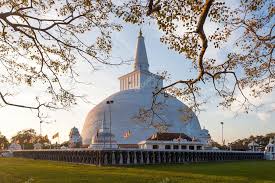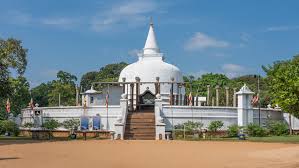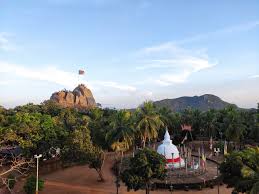Anuradhapura, one of Sri Lanka’s ancient capitals, is a UNESCO World Heritage site rich in history and cultural significance. Located in the north-central part of the island, it was the center of Sri Lankan civilization for over a thousand years. The city is renowned for its well-preserved archaeological sites, including monumental stupas, ancient temples, and vast reservoirs. Key highlights include the Sri Maha Bodhi, a sacred tree believed to be a cutting from the original Bodhi tree under which the Buddha attained enlightenment, and the massive Ruwanwelisaya Stupa, a symbol of Sinhalese Buddhist heritage. Anuradhapura is also home to intricate stone carvings, ancient monastic complexes, and the remains of royal palaces. With its rich spiritual and historical legacy, Anuradhapura offers a fascinating glimpse into Sri Lanka’s ancient Buddhist culture and the island’s early kingdoms.
Ruwanwelisaya Stupa

The Ruwanwelisaya Stupa, located in Anuradhapura, is one of Sri Lanka’s most revered and impressive ancient monuments. Built by King Dutugemunu in the 2nd century BCE, the stupa is a symbol of the king’s triumph over his southern rivals and his dedication to Buddhism. Standing at 55 meters (180 feet) tall, it is one of the largest and most majestic stupas in the country.
The Ruwanwelisaya is known for its perfectly symmetrical dome and beautifully crafted stone carvings. It is surrounded by a series of smaller shrines, stone pillars, and bathing tanks, and features beautiful frescoes depicting the life of the Buddha. The stupa is also an important pilgrimage site, attracting devotees from across Sri Lanka and beyond.
Visiting Ruwanwelisaya offers both spiritual significance and architectural beauty. Its serene atmosphere, combined with the grandeur of the structure, makes it one of Sri Lanka’s most iconic cultural landmarks and a must-visit site for anyone exploring the island’s ancient heritage
The Sri Maha Bodhi tree, located in Anuradhapura, is one of the most sacred and venerated Buddhist sites in Sri Lanka. It is believed to be a direct descendant of the Bodhi tree under which the Buddha attained enlightenment in Bodh Gaya, India. The tree was planted in 288 BCE by Sanghamitta, the daughter of Emperor Ashoka of India, and it has since become a symbol of Sri Lanka’s deep spiritual heritage.
The Sri Maha Bodhi is over 2,300 years old, making it the oldest living historical tree with a recorded history. The site is an important pilgrimage destination for Buddhists, who come to pay their respects, meditate, and offer prayers. The area surrounding the tree is beautifully landscaped, with a white marble platform and a protective railing. It is also home to a sacred Bo-tree shrine.
Visiting the Sri Maha Bodhi offers a profound experience, connecting visitors with the spiritual legacy of Buddhism in Sri Lanka..
Sri Maha Bodhi tree

Jetavanaramaya Stupa

The Jetavanaramaya Stupa, located in Anuradhapura, is one of the largest and most impressive ancient stupas in Sri Lanka. Built during the reign of King Mahasena in the 3rd century CE, it was originally constructed to house relics of the Buddha. The stupa stands at an astounding height of 122 meters (400 feet), making it one of the tallest structures in the ancient world and one of the largest brick-built monuments ever created.
The Jetavanaramaya is renowned for its massive scale and architectural ingenuity. Its construction required an enormous amount of bricks, with estimates suggesting over 93 million bricks were used. The stupa’s dome is surrounded by a series of smaller bathing pools, stone pillars, and monastic buildings, reflecting the grandeur of the ancient Buddhist monastic complex.
As a key pilgrimage site, the Jetavanaramaya is a symbol of Sri Lanka’s Buddhist heritage, offering a serene and awe-inspiring experience for visitors interested in exploring the island’s ancient spiritual history.
The Thuparamaya Stupa, located in Anuradhapura, is one of Sri Lanka’s oldest and most significant Buddhist stupas. Built by King Devanampiya Tissa in the 3rd century BCE, it was the first stupa to be constructed in Sri Lanka after the island embraced Buddhism. The stupa holds great historical and religious importance, as it is said to enshrine a relic of the Lord Buddha’s collarbone, making it one of the holiest sites for Buddhist pilgrims in the country.
The Thuparamaya Stupa is relatively small compared to other stupas in Anuradhapura but is architecturally significant. Its circular dome is surrounded by stone pillars and sculptures depicting scenes from Buddhist lore. The stupa’s design follows early Sinhalese architectural principles and reflects the blend of simplicity and grandeur in ancient Sri Lankan stupas.
Visiting Thuparamaya offers a serene spiritual experience and provides insight into the early days of Buddhism in Sri Lanka, making it an essential stop for history and religious enthusiasts.
Thuparamaya Stupa

Abhayagiri Stupa

The Abhayagiri Stupa, located in Anuradhapura, is one of the most important and monumental structures of ancient Sri Lanka. Built during the reign of King Valagamba in the 1st century BCE, this vast stupa is part of the Abhayagiri Monastery, a renowned Buddhist monastic complex that once housed over 5,000 monks. The stupa itself stands at about 75 meters (246 feet) tall and was originally designed to enshrine sacred relics of the Buddha.
The Abhayagiri Stupa is an architectural marvel, with its massive, perfectly symmetrical dome and beautifully decorated stone pillars. Surrounding the stupa are a series of smaller shrines, bathing pools, and pilgrimage structures, creating a serene and spiritual atmosphere. The stupa’s brick construction and meticulous design reflect the sophisticated engineering and craftsmanship of the time.
As a historical and religious landmark, the Abhayagiri Stupa holds immense cultural significance, offering visitors a sense of tranquility and connection to the ancient Buddhist heritage of Sri Lanka. It’s a must-visit site for those exploring the rich spiritual landscape of Anuradhapura.
Isurumuniya Temple, located near Anuradhapura, is a picturesque and historically significant Buddhist site. Built during the reign of King Devanampiya Tissa in the 3rd century BCE, the temple is renowned for its remarkable rock carvings, stunning architecture, and serene atmosphere. It is situated by a small man-made lake, adding to its tranquility and beauty.
The temple is most famous for its rock-cut Buddha statues and the Isurumuniya Lovers, an intricately carved relief depicting a royal couple in an affectionate embrace. This sculpture is one of Sri Lanka’s best-known pieces of ancient art, symbolizing love and devotion. The temple also features ancient stone pillars, shrine rooms, and a stone image house with carvings that reflect the island’s rich Buddhist heritage.
Isurumuniya Temple is an essential stop for visitors interested in exploring the art, culture, and spiritual history of Anuradhapura. Its serene location and stunning carvings make it one of Sri Lanka’s most captivating ancient sites.
Isurumuniya Temple

Lankarama Stupa

The Lankarama Stupa is a small but significant Buddhist monument located in Anuradhapura, Sri Lanka. Built during the reign of King Voharika Tissa in the 2nd century BCE, the stupa is part of the Lankarama Monastery and is renowned for its historical and religious importance. It is said that the stupa was constructed to house sacred relics of the Buddha.
The Lankarama Stupa is unique for its architectural features, especially its square-shaped base and the presence of stone balustrades and pillars surrounding the structure. Though smaller compared to other stupas in Anuradhapura, its historical significance lies in its connection to early Sinhalese Buddhist architecture and the influence of the Theravada tradition.
The stupa is an excellent example of the architectural evolution of ancient Sri Lanka and offers visitors a serene atmosphere to reflect on the island’s Buddhist heritage. The surrounding monastery grounds also include stone sculptures and pools, adding to its tranquil beauty.
The Mirisawetiya Stupa, located in Anuradhapura, is one of the most revered and historically significant stupas in Sri Lanka. It was built by King Dutugemunu in the 2nd century BCE to commemorate his victory over the Tamil king Elara and his dedication to Buddhism. According to legend, after his victory, King Dutugemunu offered a portion of his meal to the Buddha, which miraculously turned into a relic, and this relic was enshrined in the Mirisawetiya Stupa.
The stupa itself stands out for its distinctive dome, and it was originally surrounded by a monastic complex with pillars, bathing pools, and smaller shrines. Over time, the stupa has undergone restoration, but it remains an important pilgrimage site for Buddhists.
The Mirisawetiya Stupa is one of the ancient city’s most cherished landmarks and serves as a reminder of the deep spiritual and cultural heritage of Sri Lanka’s Buddhist tradition. Its peaceful surroundings and historic significance make it a must-visit site in Anuradhapura.
Mirisawetiya Stupa

Kuttam Pokuna (Twin Ponds)

The Kuttam Pokuna, or Twin Ponds, is an exquisite and historically significant site located in Anuradhapura. These ancient bathing ponds were constructed during the reign of King Aggabodhi II in the 8th century CE and are considered remarkable examples of ancient Sri Lankan hydraulic engineering. The twin ponds are known for their symmetry and intricate design, with each pond having a similar shape and size, connected by a series of stone steps.
The ponds were used by monks for ritual purification and bathing, as part of the monastic complex nearby. The larger pond, often referred to as the northern pond, has a deeper structure, while the smaller, southern pond is shallower. Both are surrounded by finely carved stone balustrades and pillars, reflecting the artistic and architectural excellence of the time.
The Kuttam Pokuna remains an outstanding example of ancient Sri Lanka’s water management systems and serves as a serene, beautifully preserved spot for visitors to appreciate the island’s heritage.
The Mihinthalaya Temple, located near Anuradhapura, is an important historical and religious site, deeply connected to the introduction of Buddhism to Sri Lanka. According to legend, this is the place where Mahinda, the Buddhist monk sent by Emperor Ashoka of India, met King Devanampiya Tissa in the 3rd century BCE. It is here that Mahinda first preached the teachings of the Buddha to the king and his court, leading to the island’s conversion to Buddhism.
The temple is set atop a rocky hill, offering panoramic views of the surrounding landscape. The site features a large rock cave with inscriptions, stone carvings, and a stupa, symbolizing its historical and religious significance. Mihinthalaya is also surrounded by a serene natural environment, making it a peaceful spot for reflection and meditation.
Visiting the Mihinthalaya Temple offers a glimpse into the pivotal moment in Sri Lanka’s spiritual history, making it a must-see site for anyone interested in the island’s Buddhist heritage.
Mihinthalaya Temple
